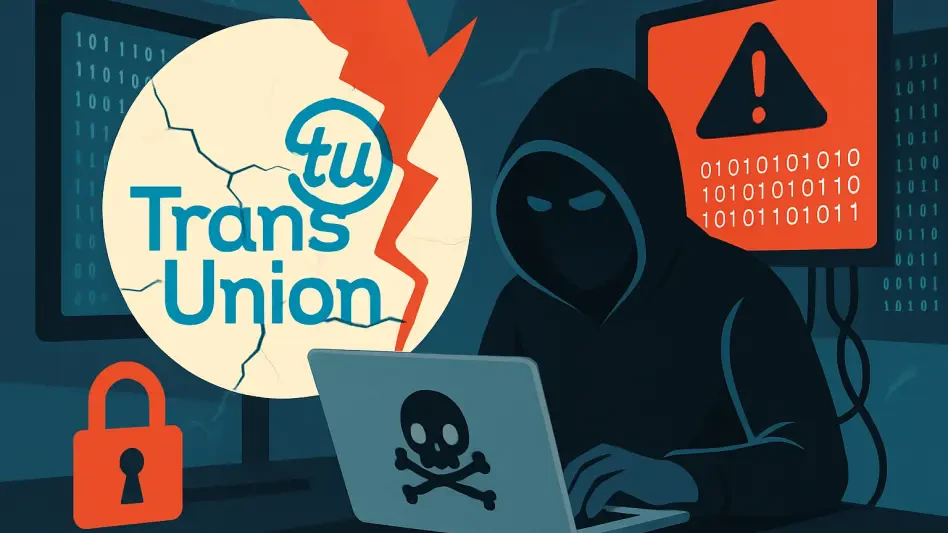Imagine discovering that your most sensitive personal information—your name, birth date, phone number, and even Social Security number—has been exposed to cybercriminals due to a massive data breach at one of the nation’s leading credit reporting agencies. This nightmare became reality for 4.4 million US consumers when TransUnion, a cornerstone of financial trust, suffered a significant cybersecurity incident starting on July 28 of this year. As the dust settles, questions arise about how such a breach could occur and what can be done to prevent future disasters. This roundup gathers insights, opinions, and actionable advice from cybersecurity experts, industry analysts, and affected stakeholders to shed light on the implications of this breach and provide guidance for both consumers and businesses.
Unpacking the Breach: How Did It Happen?
Third-Party Vulnerabilities in the Spotlight
Cybersecurity professionals across the board point to third-party applications as the Achilles’ heel in TransUnion’s defenses. The breach originated from a customer support tool, identified as Salesloft Drift, which was integrated with Salesforce databases. Many experts emphasize that attackers exploited this connection not through sophisticated coding hacks, but by leveraging human error, a tactic that’s becoming alarmingly common. This incident has sparked a debate on whether companies can truly secure their ecosystems when relying on external providers for critical operations.
Another perspective highlights the role of specific threat actors, with some industry watchers linking the attack to a group known for targeting platforms like Salesforce. There’s consensus that third-party integrations, while essential for efficiency, often lack the rigorous security vetting needed to withstand modern cyber threats. This gap leaves even well-protected organizations vulnerable to breaches through their partners’ systems.
A differing view suggests that the blame isn’t solely on third-party tools but on the overarching dependency culture in corporate tech environments. Some analysts argue that businesses prioritize functionality over security, often overlooking the risks associated with interconnected platforms. This breach serves as a stark reminder that every link in the digital chain must be fortified against potential exploitation.
Social Engineering: The Human Factor
Beyond technical vulnerabilities, a significant number of cybersecurity specialists underscore the role of social engineering in this incident. Attackers reportedly manipulated employees into granting access to malicious applications, bypassing traditional security barriers. This tactic reveals a persistent weakness in human training and awareness, with many experts calling for a shift in how companies prepare their staff to recognize deceptive practices.
On the flip side, some industry voices argue that while employee training is crucial, it’s not a silver bullet. They note that even the most vigilant individuals can fall prey to increasingly sophisticated scams tailored to exploit trust. This perspective pushes for systemic solutions, such as automated detection systems, to complement human defenses and catch suspicious activity before it escalates.
A third angle focuses on the psychological tactics used by cybercriminals, which are designed to exploit natural human tendencies like helpfulness or urgency. Analysts in this camp advocate for simulated phishing exercises and continuous education programs to build resilience among employees. The TransUnion case, they argue, exemplifies why human-centric defenses must evolve alongside technological ones to counter these silent but devastating attacks.
Impact and Implications: What’s at Stake?
The Scale of Data Exposure
Industry reactions to the scope of the TransUnion breach vary, but there’s widespread alarm over the nature of the compromised data. With names, birth dates, phone numbers, and unredacted Social Security numbers stolen for 4.4 million US consumers, many experts warn of heightened risks for identity theft and fraud. This type of data, unlike mere contact information, provides cybercriminals with the keys to wreak havoc on individuals’ financial lives.
Some cybersecurity analysts express concern over TransUnion’s characterization of the exposure as “limited,” arguing that the inclusion of Social Security numbers dramatically escalates the potential harm. They point out that such sensitive identifiers can be used for long-term exploitation, far beyond immediate scams. This viewpoint urges a reevaluation of how breaches are publicly framed to ensure transparency about real risks.
Others take a more measured stance, acknowledging that while the data loss is severe, it did not impact TransUnion’s core credit database or reports. This group suggests that the immediate danger might be contained if swift protective measures are implemented. However, they caution that the long-term consequences of such exposures often unfold over years, necessitating sustained vigilance from affected consumers.
Ripple Effects Across Industries
The TransUnion incident isn’t viewed in isolation, as many industry observers see it fitting into a broader pattern of third-party cyberattacks targeting major corporations. Similar breaches at companies like Google, Cisco, and Qantas have fueled discussions about systemic risks in interconnected business ecosystems. Experts largely agree that no sector is immune, with cybercriminals increasingly focusing on supply chain weaknesses to access valuable data troves.
A contrasting opinion emerges from analysts who believe that while the trend is concerning, it also presents an opportunity for cross-industry collaboration. They advocate for shared standards and protocols to secure third-party integrations, suggesting that collective action could turn the tide against these pervasive threats. This perspective sees the breach as a catalyst for uniting businesses in a common defense strategy.
Yet another viewpoint warns against overgeneralizing these incidents, noting that each breach carries unique characteristics based on the targeted organization’s structure and dependencies. Some professionals stress the importance of tailored risk assessments over blanket solutions, arguing that TransUnion’s case highlights specific gaps in customer support tools that may not apply universally. This nuanced take calls for customized approaches to cybersecurity challenges.
Practical Advice: Protecting Yourself and Your Business
Tips for Consumers
For consumers affected by the breach, cybersecurity advisors universally recommend taking advantage of TransUnion’s offer of free credit monitoring services. This step can help detect unauthorized activity early, providing a crucial safety net. Additionally, experts suggest placing a freeze on credit files to prevent fraudulent accounts from being opened in victims’ names, a proactive measure to safeguard financial integrity.
Another piece of advice centers on personal vigilance, with many specialists urging individuals to regularly check bank statements and credit reports for anomalies. Changing passwords frequently and using complex, unique combinations for different accounts is also widely advised. This habit, though simple, can significantly reduce the risk of further exploitation stemming from stolen data.
A less commonly discussed but equally important tip is to be cautious of phishing attempts that may follow the breach. Cybercriminals often use exposed information to craft convincing emails or calls impersonating legitimate entities. Experts encourage skepticism toward unsolicited communications and verifying requests through official channels before sharing any personal details, a practice that can thwart secondary attacks.
Strategies for Businesses
On the corporate side, industry leaders stress the need for comprehensive audits of third-party partnerships. Businesses are encouraged to map out all external tools and services in use, assessing each for potential security flaws. This process, though time-intensive, is seen as essential to identifying weak points before attackers do, a lesson drawn directly from TransUnion’s experience.
Diverging slightly, some cybersecurity consultants advocate for stricter vendor selection criteria, emphasizing that cost should never outweigh security in decision-making. They propose mandatory penetration testing and regular compliance checks for third-party providers as non-negotiable standards. This rigorous approach aims to elevate the baseline of trust in external collaborations.
Finally, a recurring recommendation is to invest in employee training focused on recognizing social engineering tactics. Many experts believe that fostering a culture of suspicion toward unusual requests or unfamiliar software can prevent breaches at the human level. Pairing this with advanced monitoring tools creates a dual layer of protection, a strategy deemed vital in today’s threat landscape.
Final Reflections and Next Steps
Looking back, the TransUnion data breach served as a sobering wake-up call for millions of consumers and countless businesses, exposing the fragility of trust in third-party systems. The incident underscored how even robust internal security could be undermined by external vulnerabilities and human error. Diverse expert opinions converged on the urgency of addressing these gaps, while differing on the balance between technological and human-centric solutions.
Moving forward, both individuals and organizations must prioritize actionable measures to mitigate risks. Consumers should actively monitor their financial accounts and consider credit freezes as a safeguard, while staying alert to potential scams. Businesses, on the other hand, need to reevaluate their reliance on external providers, pushing for tougher security standards and fostering employee awareness. Exploring industry-wide initiatives to share threat intelligence could also pave the way for stronger collective defenses, ensuring that such breaches become less frequent and less devastating in the years ahead.








